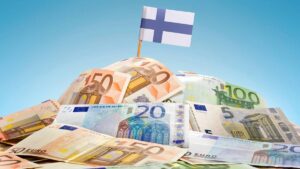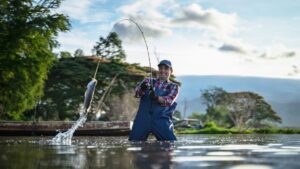King in the North? Why these ASX explorers are hunting for critical minerals in Europe’s Nordic region

ASX companies are turning to the Artic to test new exploration theories in areas with a proven history of high-grade metal production. Pic: Getty Images
A handful of Aussie explorers are making the trek to Europe, the fastest growing hub for EV battery cell production outside of China, in a bid to carve out a new lease of life on mineral-rich deposits in the Nordic region.
Mining activity in Europe’s Nordic countries, a collection of five sovereign states (Sweden, Iceland, Denmark, Norway, and Finland) dates as far back as the 9th century when Sweden’s 1,000-year-old Falun copper mine began production.
Since then, the region’s location and long history of supplying Europe with minerals has attracted a growing number of international mining companies looking to get their foot into the door of one of the oldest (and politically stable) mining regions in the world.
The prosperity of mining and exploration in this part of the world goes hand-in-hand with the Nordic region’s highly mineralised, massive greenstone belts which contain copious amounts of base metals (copper, nickel, and zinc) as well as iron ore and gold.
These resources, traditionally used as materials in the construction of buildings and gas turbines, are now gaining a new lease of life as so-called ‘critical minerals’ vital in the production of major green energy technologies like batteries, EVs, wind turbines and photovoltaics.
The Nordic opportunity
Just like the rest of the world, Europe is throwing financial muscle behind critical minerals and respective projects, in the hopes it can work its way out of the control of a belligerent competing power.
Critical minerals face a high risk of supply chain disruption, with China controlling 60% of worldwide production and 85% of processing capacity.
But what sets the Nordic region apart is its proximity to major automakers and battery gigafactories as well as its host of key industry actors along the full battery value chain.
One of Europe’s largest battery-gigafactories is being constructed by Northvolt AB in northern Sweden, with another two underway in Finland.
ASX-listed explorers, like Nordic Nickel (ASX:NNL), are turning to Nordic countries to get closer to the action and to test new exploration theories in areas with a proven history of high-grade metal production.
Sitting down with Stockhead, NNL managing director and CEO Todd Ross says of all the gigafactories being built in Europe, 20% of them are taking place in Nordic countries.
“That’s very important considering there’s only two operating nickel mines in all of Europe and they’re both in Finland,” he says.
“When you look at the EU Critical Minerals Act released in March this year, the continent requires 10% of all critical minerals to be sourced from operations in Europe.
“At the moment, there’s less than 3%, so there’s a huge growth opportunity there.
“Finland and Norway host the entirety of European nickel smelting and refining capacity which will be become even more important now with the energy transition and Europe looking to secure supply onshore.”
Nordic Nickel
NNL owns the Pulju nickel project within the same geological setting as the world-class Kevitsa (Boliden) and Sakkati (Anglo American) nickel deposits in Finland’s Central Lapland Greenstone Belt. Sakatti is one of the world’s biggest nickel-copper discoveries boasting a 44Mt resource at 1.9% copper and 1% nickel.
Pulju hosts both shallow disseminated nickel sulphides and high-grade massive sulphides over its 240km2 land package, with NNL focused on finding ‘Sakatti-style’ analogues.
Pulju’s 133.61Mt resource grading 0.21% nickel plus its revised exploration target of 275-415Mt at 0.17-0.25% nickel and 76-114ppm cobalt for 459-1,032kt contained nickel and 21-47kt contained cobalt is based only on the near-surface disseminated mineralisation.
Since its release in 2022, the company has drilled another 15,000m and is looking to put out an updated mineral resource estimate by the end of the year.
“We’re exploring less than 2% – or just 5km – of our total landholding and our mineralised strike stretches for 35km,” Ross says.
“It’s incredible scale.
“More drilling results will be released in the lead up to the end of the year as we start our planning and targeting for next year’s campaign.”
Nordic Nickel also has the backing of the world’s biggest miner, BHP (ASX:BHP), as a recipient of $500,000 in cash and advice under the so called ‘BHP Xplor program’.
“What BHP are looking to do is build out massive growth in their copper and nickel portfolio with companies that own projects in jurisdictions that they were willing to operate in or could get comfortable to operate in,” Ross says.
“They’re looking at projects with district scale, there are only seven companies that were selected out of 250 and we ticked those boxes largely because of our size but also because of where we are located in that part of the world in Europe.”
Who else is exploring Europe’s Nordic region?
Alicanto Minerals (ASX:AQI)
AQI now owns the ‘monster’ 1,000-year-old Falun mine which historically produced 28Mt at 4% copper, 4g/t gold, 5% zinc, 2% lead, and 35g/t silver in its heyday.
At the end of September, the company started drilling for repeats of a Falun-style deposit following recent fieldwork including mapping, electromagnetic and gravity surveys.
This work generated numerous targets, which AQI believes could be just a small part of a major mineralised belt stretching over 10km.
A minimum of 5,000 metres is planned in the current program, which aims to test high priority targets around the historic Falun mine as well as the highly prospective 3.5km trend which runs between Falun and the high-grade mineralisation intersected at the Skyttgruvan-Naverberg target.
At Skyttgruvan-Naverberg, the company has identified assays up to 744g/t silver, up to 1.9% copper, and up to 6.65g/t gold within broader zones of zinc (assays up to 32.4%).
Aura Energy (ASX:AEE)
Aura’s Häggån discovery in the Jämtland province in central Sweden is home to a polymetallic resource of 1.96 billion tonnes grading 0.3% vanadium pentoxide (V2O5), 212 parts per million (ppm) molybdenum, 337ppm nickel, 463ppm zinc and 3.8% K2O (potash).
Häggån also has economically extractable quantities of sulphate of potash (SOP), nickel, zinc and molybdenum that provide valuable by-product credits.
Should Sweden lift its ban on uranium extraction, it will substantially improve the likelihood of AEE pushing ahead with developing Häggån, as – like many deposits in the country – uranium is present as part of the polymetallic resource.
The project is expected to deliver post-tax net present value (NPV) of between US$380m and US$1,231m as well as internal rate of return of 26% to 47% depending on the price of vanadium – calculated here at between US$7/lb to US$13/lb.
This is based on the production of 10,400tpa of V2O5 and 217,000tpa of SOP.
Kingsrose Mining (ASX:KRM)
Kingrose was also selected to receive funding and support under the BHP Xplor program given its exposure to nickel, copper and platinum group elements.
The company owns the Rana project in Norway, which includes the underground Bruvann mine, as well as the Porsanger nickel and copper project in Norway’s far north and the Penikat project in Finland.
KRM recently intersected 9.3m at 1% nickel and 0.3% copper in a newly discovered sulphide zone at the Rånbogen prospect within the Rana project.
Kingrose MD Andrew Tunningley said the results are consistent with the company’s view that the wider Råna intrusion has substantial potential to host significant mineralisation outside of the historical mine.
“The whole intrusion outcrops over 70 square kilometres, with mineralised prospects at surface across the exposed highly prospective lower zone of the intrusion, which remains under-explored,” he says.
QX Resources (ASX:QXR)
The Steve Promnitz-led explorer QX Resources acquired 39% of unlisted Aussie company Bayrock Resources, which has a portfolio of nickel-copper-cobalt projects in Sweden.
Bayrock’s Vuostok project is located roughly 60km northwest of the Lainejaur project, offering a potential joint development opportunity as a ‘district play’.
The newly added Nr 102 lease expands the total mineral lease by 33% at Vuostok, which QXR says could be within potential trucking distance to Lainejaur given the well-established all-weather road network and supporting infrastructure in the district.
“This would benefit any future standalone nickel-copper-cobalt operations or provide additional ore feed for a possible Lainejaur development,” the company says.
“Trucking of ore material for processing is a regular feature of operations in this part of northern Sweden.”
Nordic explorers share prices today:
At Stockhead we tell it like it is. While Nordic Nickel, Alicanto Minerals, Aura Energy, and QX Resources are Stockhead advertisers, they did not sponsor this article.

UNLOCK INSIGHTS
Discover the untold stories of emerging ASX stocks.
Daily news and expert analysis, it's free to subscribe.
By proceeding, you confirm you understand that we handle personal information in accordance with our Privacy Policy.








